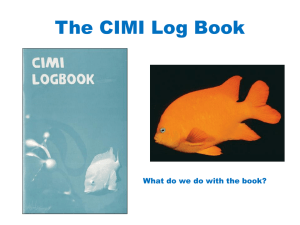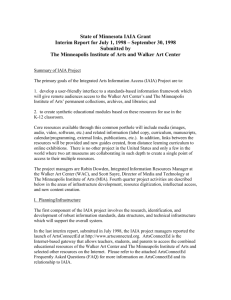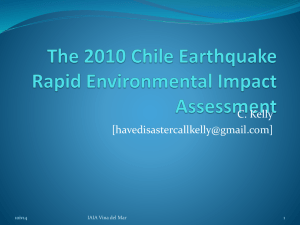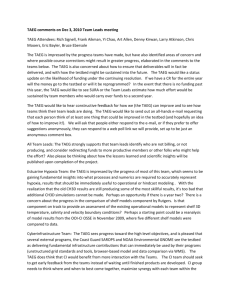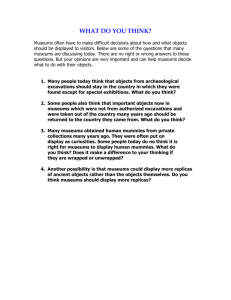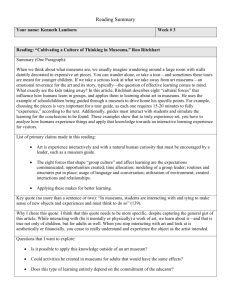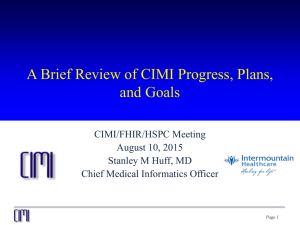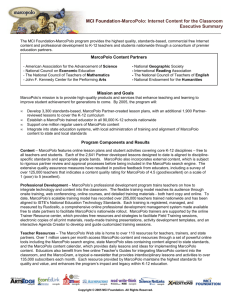Word - Walker Art Center
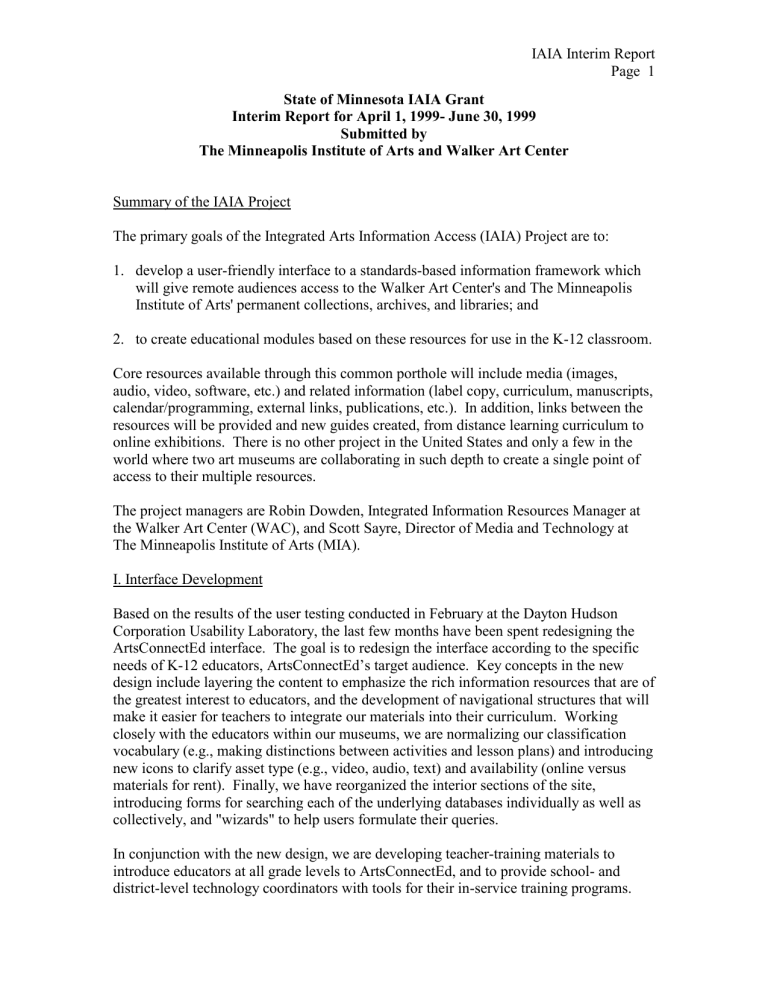
IAIA Interim Report
Page 1
State of Minnesota IAIA Grant
Interim Report for April 1, 1999- June 30, 1999
Submitted by
The Minneapolis Institute of Arts and Walker Art Center
Summary of the IAIA Project
The primary goals of the Integrated Arts Information Access (IAIA) Project are to:
1. develop a user-friendly interface to a standards-based information framework which will give remote audiences access to the Walker Art Center's and The Minneapolis
Institute of Arts' permanent collections, archives, and libraries; and
2. to create educational modules based on these resources for use in the K-12 classroom.
Core resources available through this common porthole will include media (images, audio, video, software, etc.) and related information (label copy, curriculum, manuscripts, calendar/programming, external links, publications, etc.). In addition, links between the resources will be provided and new guides created, from distance learning curriculum to online exhibitions. There is no other project in the United States and only a few in the world where two art museums are collaborating in such depth to create a single point of access to their multiple resources.
The project managers are Robin Dowden, Integrated Information Resources Manager at the Walker Art Center (WAC), and Scott Sayre, Director of Media and Technology at
The Minneapolis Institute of Arts (MIA).
I. Interface Development
Based on the results of the user testing conducted in February at the Dayton Hudson
Corporation Usability Laboratory, the last few months have been spent redesigning the
ArtsConnectEd interface. The goal is to redesign the interface according to the specific needs of K-12 educators, ArtsConnectEd’s target audience. Key concepts in the new design include layering the content to emphasize the rich information resources that are of the greatest interest to educators, and the development of navigational structures that will make it easier for teachers to integrate our materials into their curriculum. Working closely with the educators within our museums, we are normalizing our classification vocabulary (e.g., making distinctions between activities and lesson plans) and introducing new icons to clarify asset type (e.g., video, audio, text) and availability (online versus materials for rent). Finally, we have reorganized the interior sections of the site, introducing forms for searching each of the underlying databases individually as well as collectively, and "wizards" to help users formulate their queries.
In conjunction with the new design, we are developing teacher-training materials to introduce educators at all grade levels to ArtsConnectEd, and to provide school- and district-level technology coordinators with tools for their in-service training programs.
IAIA Interim Report
Page 2
The redesign of ArtsConnectEd is scheduled for completion by July 31, 1999. A prototype of our training materials (also referred to as a "cookbook" of ideas for integrating ArtsConnectEd in the classroom) will be developed in time for the Teacher
Institute which will be held on August 23-24 and sponsored by Twin Cities museums.
II. Intellectual Access
In June, Robin Dowden attended a meeting of the Dublin Core Metadata Testbed Project sponsored by the Consortium for the Computer Interchange of Museum Information
(CIMI). CIMI is a group of cultural heritage organizations who have agreed to work cooperatively to solve problems relating to the electronic interchange of museum information.
The Dublin Core Metadata Element Set (also known as "Dublin Core" or simply "DC") is a set of 15 data elements that can be used to describe a wide variety of information resources on the Internet for the purpose of simple cross-disciplinary resource discovery.
The elements and their meanings have been developed and refined by a group of librarians, information specialists, and subject specialists, through an ongoing consensusbuilding process that has included international workshops and active DC mailing lists which relate to specific working groups or special interest areas. The CIMI project – which is defining the elements for the museum community – is the most active DC special interest group.
Last year, participants in the CIMI project authored a Guide to Best Practice for Using
Dublin Core Simple to describe museum information. The guide was sent out for peer review, and the comments resulting from that review were incorporated in the guide during the June meeting. Each participant in the CIMI project is responsible for resubmitting testbed records according to the final version of the guide. The testbed is hosted by AdLib Information Systems in the Netherlands. It can be accessed at http://cimi.adlibsoft.com/dct/data/dct.html
and includes all of the Walker's object records
(8,000+).
The remainder of the meeting was spent discussing qualified DC, how to evaluate the testbed, and CIMI Institute curriculum. The CIMI Institute is a professional development curriculum that will address the DC as well as the syntax for expressing it (XML), and the structure (RDF - Resource Description Framework). As a consequence of our participation in this project, the CIMI Institute will be offered in Minneapolis during the year 2000.
In June, Tammy Sopinski attended the Art Museum Image Consortium (AMICO) annual meeting in Pittsburgh. AMICO is a not-for-profit membership association of museums and other art-collecting institutions. Together, AMICO members are creating a multimedia digital library documenting their collections and making it available for educational use. AMICO’s database of images is distributed online by Research Library
Group and has just completed its “testbed” year. The annual meeting presented the opportunity for users and contributors to meet face to face.
IAIA Interim Report
Page 3
The first half of the meeting included AMICO contributors and representatives from the
University Testbed institutions. Testbed members gave presentations on the different ways they have been using AMICO for research and in the classroom. They also told contributors what they would like to see in the future, and what would make AMICO more helpful for them. A decision was made to extend the testbed period in order to evaluate how students and faculty have adapted to using digital images in the classroom after their initial introduction to the concept. Tammy demonstrated the ArtsConnectEd website to the testbed participants, to show ways that museums are using their digitized images and technology for education in the galleries and on the Internet. The remainder of the meeting was spent with contributors setting goals and discussing ways to further implement data standards between the diverse group of museums.
III. Creating New Content
The Minneapolis Institute of Arts continued to work on its second online curriculum unit,
Get the Picture: Thinking About Photographs . Using photographs from the permanent collection of the MIA, Get the Picture examines both the process of making pictures and the resulting works of art. Students think about photographs through investigation of the work of provocative and prominent twentieth-century photographers, and gain insight into their own photographs and opinions about photography. This new educational unit is slated for launch during July of 1999.
The Walker Art Center continued to develop Through Your Eyes , completing the online tour of Herman Milligan. A member of Walker’s Community Advisory Committee,
Herman advises the Walker on ways to maintain cultural diversity at all levels of the institution's operations. In his introduction at the beginning of his tour, Herman states:
"What I've understood, or grown to know over my life, is that everyone—being a musician myself—hears the music in a different way, relative to their background. And what's important to figure out is how they interpret the music or how they interpret art based on their own particular experiences."
IAIA Interim Report
Page 4
IV. Measurement Data
Since its launch on October 1, 1998, ArtsConnectEd has witnessed a steady increase in usage. The following statistics report user sessions. During this period, the average session length was 8:34 minutes.
ArtsConnectEd User Sessions
12000
10000
8000
6000
4000
2000
0
Oct-
98
Nov-
98
Dec-
98
Jan-
99
Feb-
99
Mar-
99
Apr-
99
May-
99
Definition: A session of activity for one user of a web site. A unique user is determined by the IP address. By default, a user session is terminated when a user is inactive for more than 30 minutes.
VI. Presentations
During the past quarter, the IAIA project teams continued their efforts to foster project awareness by making presentations at various professional development conferences. In
April, IAIA project members went to Cleveland for the annual meeting of the Association of American Art Museums (AAM). At AAM, an entire session was devoted to the project: Robin Dowden, Jim Blackaby, Jackie Copeland, and Scott Sayre presented the project from the point of view of inter-institutional project management, infrastructure, impact on educators, and evaluation. In June, the project was featured in presentations made at the Minnesota Association of Museums (Saint Paul) and the American Libraries
Association (New Orleans).
On June 8, IAIA was represented by Robin Dowden and Kathryn Ross at the Summit on
Internet Content for the Classroom, hosted by MCI and the MarcoPolo Partnership.
MarcoPolo is a partnership between the MCI WorldCom Foundation and leading educational organizations that have created standards-based Internet content for the classroom through five discipline-specific educational websites. MarcoPolo professional development curriculum provides a model for the ArtsConnectEd teacher training materials discussed above.
